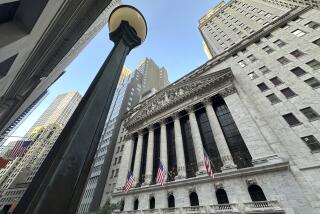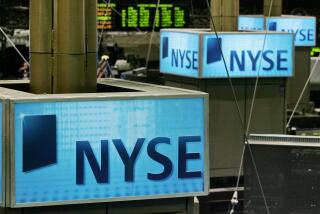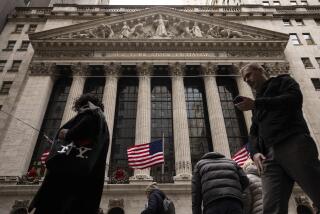Wall St. Unworried by Signs of Rising Rates
- Share via
The Federal Reserve signaled Tuesday that it stands poised to raise interest rates later this year. But so far, the stock market isn’t acting terribly threatened by that possibility.
That’s because many investors are betting that the same force that would drive rates higher--a recovering economy--also would power a sharp rebound in corporate earnings.
Recent history shows that, while rising interest rates can present a hurdle for the market as corporate borrowing becomes more costly, stock prices can advance in periods when the Fed is tightening credit--as long as profits are growing and inflation stays tame.
Since 1985 there have been eight periods when the Fed was raising its benchmark short-term rate, the federal funds rate. Each time, the blue-chip Standard & Poor’s 500 stock index was higher one year after the first Fed rate increase.
The average price gain after one year: 15.2%.
Major stock indexes closed modestly higher Tuesday after the Fed kept its key short-term rate unchanged at 1.75%, but also shifted its “bias” on rates to neutral, which is the first step to eventually raising credit costs.
“For the market, the important question is whether profits rebound, and how strongly,” said Russ Koesterich, investment strategist at New York brokerage Instinet Corp.
Investors anticipated that the Fed would change its bias Tuesday, given stronger-than-expected economic data in recent weeks. Those same data are encouraging investors to expect corporate profits to resurge, after a decline last year that was the worst in a generation despite what now appears to have been a mild recession.
Chuck Hill, research director at earnings-tracker Thomson Financial/First Call in Boston, said analysts expect S&P; 500 companies’ operating earnings in the second quarter to post their first year-over-year gain since the fourth quarter of 2000.
Analysts surveyed by First Call expect first-quarter S&P; earnings to fall 8.6% from a year earlier, before adjustments for a change in accounting standards that eliminates the need for many companies to write off “goodwill.” That would be a major improvement on the fourth quarter’s 21.7% drop.
Analysts also expect second-quarter S&P; earnings to be up 9%, followed by a 30.9% jump in third-quarter results and a 41.7% surge in fourth-quarter results.
The big question is whether those numbers are reasonable, or far too optimistic--and how much of an earnings turnaround already is built into stock prices.
“The news on both the economy and earnings should be good for a while,” Hill said. But he said third- and fourth-quarter estimates may be too glowing.
Hill cautioned that second-half estimates for the hard-hit technology sector of the S&P;, in particular, might be too rosy. After a 25% drop for tech earnings in the first quarter, analysts expect a 38% rise in the second quarter, then a 132% jump in the third and a 72% surge in the fourth.
“That 132% number sticks in my craw,” Hill said. “That’s a big swing.”
Even outside the tech area, Hill said, lingering “Enronitis” could keep 2002 profit gains limited.
“Companies are going to push the envelope less and auditors are going to be more vigilant,” he said. “When you put it all together you have to be a little skeptical about these earnings projections coming out of a recession.”
Jeremy Siegel, finance professor at the University of Pennsylvania and author of “Stocks for the Long Run,” said stocks ran up in the fourth quarter in anticipation of an earnings turnaround this year.
“That profit recovery is built into stock prices, so the threat to the market is that it fails to materialize,” Siegel said.
By tempering the economy, higher interest rates may set the stage for “moderate but unspectacular” stock gains this year, he said: “We’ll probably see ragged, upward movement, but not a strong bull market taking hold.”
Still, many analysts say that even if the Fed begins to raise rates, the increases should be moderate. The federal funds rate may rise just to 2.25% by summer, Koesterich said.
The Fed would just be bringing rates back to normal, up from the “panic” levels set after Sept. 11, analysts said.
If short-term rates were jacked up a full percentage point by later in the year, they would still be low by historical standards, experts note.
Even if the Fed’s overall impact is muted, a climate of rising rates can weigh on certain stock sectors, such as autos, analysts say. But some say “cyclical” industries such as chemicals and semiconductors are now in the market’s sweet spot because their fortunes are leveraged to an economy on the brink of bouncing back.
In the financial sector, Koesterich said brokerage stocks could benefit from a pickup in mergers and acquisitions, along with initial public offerings of stock.
Smaller stocks have outperformed larger stocks for the last two years, but Koesterich said blue chips could hold their own in a rising rate environment--assuming that a stronger dollar attracts more foreign investors, who often seek out big-name stocks first.
The dollar has rallied back in recent days against the yen, after sliding early in March. The dollar has weakened only modestly against the euro currency in recent weeks.
*
(BEGIN TEXT OF INFOBOX)
Stocks’ Performance as Credit Tightens
(text of infobox not included)
*
Betting on a Profit Rebound
(text of infobox not included)
More to Read
Inside the business of entertainment
The Wide Shot brings you news, analysis and insights on everything from streaming wars to production — and what it all means for the future.
You may occasionally receive promotional content from the Los Angeles Times.










